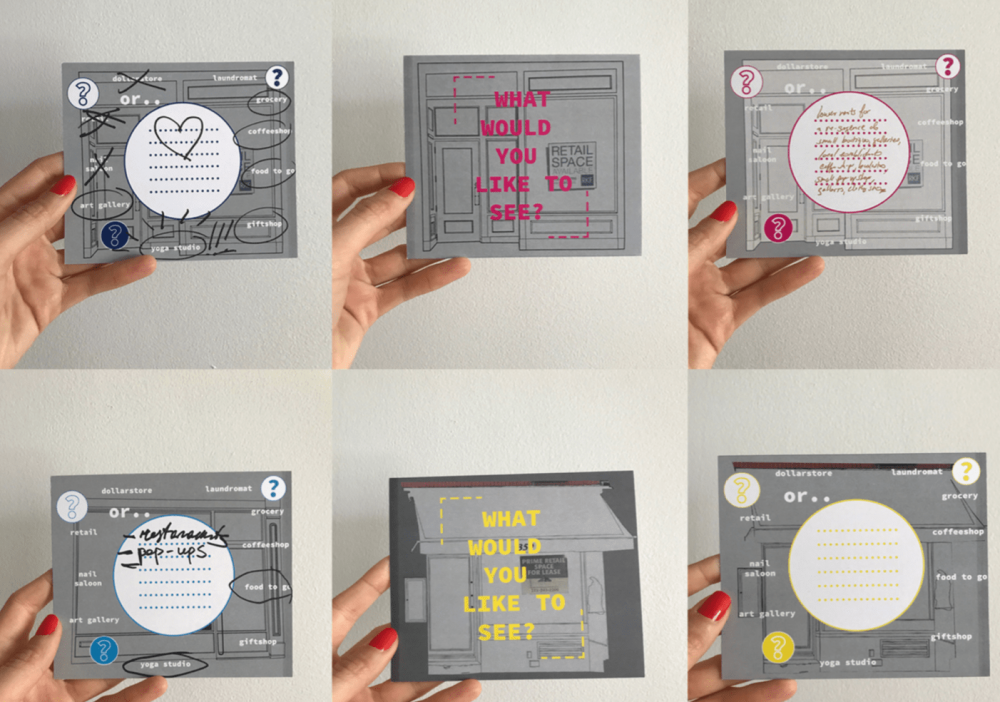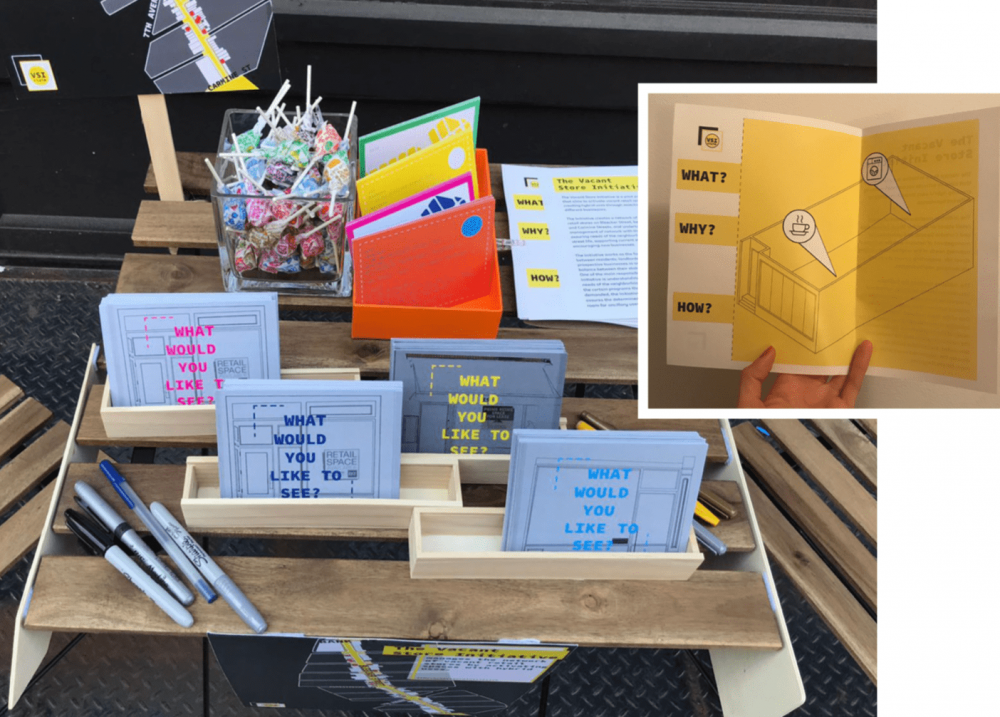The Vacant Store Initiative: A Model for Alternative Retail Space
Irem C. Yildiz
“We can design the material (and even the economic and regulatory) conditions that could make the development of such a city more probable.”1 — Ezio Manzini
The Vacant Store Initiative is an investigation of a complicated urban problem. The project developed as a form of design activism following a case study on long-term vacant retail stores on Bleecker Street—a cultural marker in New York City. It is my belief that by looking at the problem through the lens of Design Studies and incorporating interdisciplinary research methods from the fields of architecture, urban studies, and design strategy, it is possible to unpack the dynamics of major forces shaping urban experience and life in cities. In order to produce meaningful research, I limited the physical area of study by the parameters of Bank Street to the north and Carmine Street to the south. The goal of the Vacant Store Initiative is to explore alternative ways of interrupting the traditional processes to create better everyday life experiences and systems by examining the historical, cultural, spatial, and social aspects of urban life on Bleecker Street, thus revealing binary relationships between concepts such as local/global, past/future, preservation/innovation, and tactic/strategy, with a search for generative balance.
Manhattan’s West Village, known as the bohemian capital of most of 19th and 20th centuries and Jane Jacobs’ proverbial castle, is populated today by vacant storefronts with the occasional real-estate agency postings on them.2 With its current and continually increasing vacancy rate, the area on Bleecker Street between Bank and Carmine Streets faces a harsh battle for survival in the city’s current real estate market, despite once being a major high-end shopping district of the 2000s. Having lost both local businesses and global retail stores, Bleecker Street is at a critical turning point.
This project explores alternative spatial practices that can emerge from the contemporary urban crisis of vacant retail stores by looking at those on Bleecker Street. It additionally serves to further design studies research on a topic mostly engaged with by architecture and urban studies scholars. While vacancy rates continue to rise, the streets of the New York have been noticeably affected. As places of exchange, streets constitute the essence of the urban experience by housing basic elements of everyday life: random interactions, conjunctions, communications, and transitions. Urban experience is generated through the various engagements between physical space, the environment, urban culture, and everyday life. In the context of this research, the increasing rate of the retail store vacancy has a direct effect on both the formation of urban experience as well as the social, cultural, and economic systems of the city. It is critical to emphasize the complexity and multilayered nature of such a crisis, which has multiple causes including a surplus of construction and development projects, the volatile dynamics of the real estate industry, and the changes in everyday life activities, needs, and habits caused by technological developments.
Why Bleecker?
Bleecker is a well-known commercial street in New York City annexing other streets in the area which concentrate on various types of retail stores, cafes, and restaurants on the ground level. It is considered the heart of the Village by those who live in the neighborhood.
Due to the effects of high rent and growing popularity in online shopping, this location faces a particular responsibility in shaping how we as urban dwellers adapt to technological and global changes in cities. Seeing the vacancy problem play out on Bleecker Street and considering its unique historical, geographical, social, and cultural significance gives the issue prominence and increases global attention to the problem. The persistent problem of increasing rent and the subsequent departure of tenants on ground-level retail shops on Bleecker Street have been of interest in the media since 2017, but some cultural commentators say Bleecker Street was propelled into pop culture the moment Sex and the City featured Magnolia Bakery, a neighborhood staple, on the show.3
A new era for the neighborhood emerged in 2001 with the opening of the first Marc Jacobs store on 403-405 Bleecker Street. At its peak around 2009–2010, Marc Jacobs had a men’s store, a collection and accessory store, a beauty store, the concept store Bookmarc, and a kid’s store all within in a four-block radius; four of these stores were on Bleecker Street and two of them were extended to the periphery in the colloquially known Bleecker Shopping Area.4 This new era of Bleecker—now a product of media consumption—has faced the challenges of a changing urban landscape where local brands and global mega-brands can’t afford to stay on the prestigious street.
The problem is not just an economic one, but also one of the street’s politics, culture, and people. In order to work toward a solution, we need to unpack those layers to provide nuance to the vacancy crisis as a growing and threatening urban issue.
Users’ Agency in Activating Space
Henri Lefebvre sees participation in social life as key to understanding spaces and cities in a larger context.5 While architects have the agency to design physical space and envision prospective life, users have the agency to transform space as they wish and need. Initiative, contribution, activity, and participation give meaning and identity to space.
The vacancy problem thus offers a unique opportunity to tackle various issues such as the ways in which urban culture is shaped by changing everyday life dynamics in globalized urban areas—or how cycles in real estate and retail industries affect urban life and experience on different levels, and how technology changes our everyday needs, expectations, and habits.
While the dichotomy between questions of theory and practice served as the catalyst for this project, the strategy is to find existing niches in the current system that would allow for intervention and innovation through the use of tactics and strategies according to the definition of those terms by Michel de Certeau, which he constructed in the context of mass production and consumption.6
De Certeau correlates strategies with the concepts of power and permanence, while tactics are more fluid, adoptable, transitory, and playful. Building off de Certeau’s ideas, Jamer Hunt defines design in the realm of strategies as such: “To design is to fix fluid relations. Design seizes space and creates place. The practice of design, then, exists in the register of strategies.”7 Hunt points out that design is the process of institutions and corporations imposing places, ideas, and concepts on everyday life. Looking at Hunt’s interpretation from a different perspective, I believe in the power of designers using tactics to disrupt conventional design processes and create alternatives.
The following is the project description for the Vacant Store Initiative. The project initially engaged with the community in 2018 and continues as interest and resources become available.
The Vacant Store Initiative
The Vacant Store Initiative activates vacant retail spaces by structuring ephemeral, programmatic, and spatial relationships. The initiative sets up as a network of vacant retail stores on Bleecker Street, between Bank and Carmine Streets, whose main focus is to manage the network and create hybrid uses of space through the cooperation of different businesses. The main purposes of the initiative are to revitalize street life and contribute to the urban culture, support current businesses, and encourage small business growth by assuring the needs of the neighborhood.
To determine the needs of the neighborhood, the initiative works closely with the members of the local community by applying various research methods such as periodic community meetings, design-thinking workshops, ethnography, and data analysis. Based on research, the initiative aims to secure the needs of the community while creating spaces for ancillary use. Using a bottom-up approach, the initiative works as the facilitator between the stakeholders including residents, landlords, and the city government, as well as current and prospective businesses to create a balance between their stakes.
The core initiative team will consist of a design strategist, an urban planner, an architect, a user researcher, a business development manager, a public relations specialist, a user experience designer, a software developer, an operations manager, a marketing and event manager, and a program manager working in collaboration with the city government and non-profit organizations.
The main responsibilities of the Vacant Store Initiative are:
• keeping track of vacant retail stores on Bleecker Street between Bank and Carmine Streets and keeping the online map updated and accessible to public
• conducting community and market research on a regular basis to keep the ratio of business types up to date
• preparing lease agreements and facilitating the processes between landlords and tenants
• structuring hybrid uses of vacant stores and matching up businesses that would be a good fit in the same space
• conducting spatial design processes and architectural implementations of participant stores
• maintenance of the participant stores
• organizing regular meetings with the community board
• advocating for the community
• supporting businesses through online platforms
• facilitating community engagement events and workshops
• organizing workshops for businesses
• managing the donation program
Community Engagement Event: April 14, 2018
Claiming my space on the street, I set up a table and two chairs from 1:00 to 3:30 PM in front of a vacant retail store on 400 Bleecker Street to tell the story of the Vacant Store Initiative and get community insight to the project. (Fig. 1) (Fig. 2)

Figure 1. The Vacant Store Initiative Community Engagement Event Setup. Irem C. Yildiz, Bleecker Street, New York, 2018.

Figure 2. The Vacant Store Initiative Community Engagement Event Setup. Irem C. Yildiz, Bleecker Street, New York, 2018.
Pursuing the Vacant Retail Store Initiative Community Engagement Event not only increased the visibility of the vacancy problem in the community by drawing attention to the subject, but it also created a platform for people who are open to listen and engage by sharing and participating if they think intervention is needed.
Based on the interviews conducted on this day, 100 percent of the 50 participants declared that they were bothered by vacant retail stores. More than 90 percent of the participants were local residents who were eager to share their perspective on the subject matter as well as participating in a conversation of sharing their wants and needs.8 While senior residents who have been living in the neighborhood since the 1960s or 1970s described the vacancy problem as the reason for “what Bleecker became,” for others it was “a disappointment to see such a beautiful and unique street so empty.”9
To initiate conversation, I designed cards which asked passersby, “What would you like to see?” Among the 49 answers to the prompt, 19 respondents claimed they wanted more food-related enterprises such as coffee shops, healthy food to-go, bodegas, and grocery stores. Art galleries, yoga studios, and independent creative stores were other popular answers. (Fig. 3)

Figure 3. The Vacant Store Initiative Survey Cards. Irem C. Yildiz, What would you like to see?, Bleecker Street, New York, 2018. Figure 4. (Image insert on right) The Vacant Store Initiative Community Catalog. Irem C. Yildiz, Catalog, Bleecker Street, New York, 2018.
From this initial design engagement, I began strategizing one type of spatial solution to the problem. One intervention came from recognizing necessary rituals in everyday life that shape the urban fabric besides shopping on this street. The idea of merging a laundromat (a site of one of the most mundane and relatable everyday life experiences to a New Yorker) with a coffee shop (a timeless program that remains highly adaptable to innovation and intervention) attracted creative responses by participants which led them to spend more time asking questions and sharing their own ideas in a collaborative way with the environment and its people. (Fig. 4)
This middle ground between bottom-up and top-down approaches opened up opportunities to tackle the problem. The application of different adaptable strategies to the process has been one of the most important points of this research in order to keep creating opportunities within challenging situations.
As a designer and researcher, I appreciate change and transformation. However, in order to be an actor of change, I find value in having a deep understanding in the most mundane and familiar concepts and practices. The Vacant Store Initiative is not an end product, but a generative process that constantly seeks a balance between theory and practice, consumption and production, the local and global, yesterday and tomorrow, as well as the concepts of being both urban and a village.
Endnotes
1 Ezio Manzini, “Public for Place,” in Human Cities: Celebrating Public Space, ed. Barbara Golicnik Marušic, Matej Nikšic and Lise Coirier (Brussels: Stitching Kunstboek, 2010), 13.↵
2 Jane Jacobs was a journalist and activist (1916-2006) who is best known for her critical works on urban renewal projects, most specifically her battle over the preservation of Greenwich Village against Robert Moses.↵
3 The popularized scene which brought international attraction to the Bleecker Street location was featured in Sex and the City, season 3, episode 5, “No Ifs, Ands, Or Butts.” Melissa Kravitz, “Secrets of Magnolia Bakery: Cupcakes, Carrie Bradshaw and beyond,” AMNY, May 7, 2016, https://www.amny.com/secrets-of-new-york/secrets-of-magnolia-bakery-cupcakes-carrie-bradshaw-and-beyond-1.11744934.↵
4 Michael Ariano (Marc Jacobs Global Head of Press) in discussion with the author, November 14, 2017.↵
5 Henri Lefebvre, The Production of Space, trans. Donald Nicholson Smith (Blackwell Publishers: New Jersey, 1994).↵
6 Michel de Certeau, The Practice of Everyday Life (California: University of California Press, 2011).↵
7 Jamer Hunt, “Just Re-Do It: Tactical Formlesness and Everyday Consumption,” in Strangely Familiar: Design and Everyday Life, ed. Andrew Blauvelt ( Minneapolis, Minn: Walker Art Center, 2003), 62.↵
8 Irem C. Yildiz, “Deciphering the Dynamics Between the Notions of Event, Space, and Community in Post-Metropolitan Cities: A Search for Alternative Spatial Practices,” Master’s thesis, Parsons School of Design, 2018, 126.↵
9 Unpublished interview conducted with the author on April 14, 2018.↵
Author Affiliations
Irem C. Yildiz is a design strategist and alumna of Parsons School of Design’s MA Design Studies program.↵

 DESIGN STUDIES BLOG
DESIGN STUDIES BLOG

